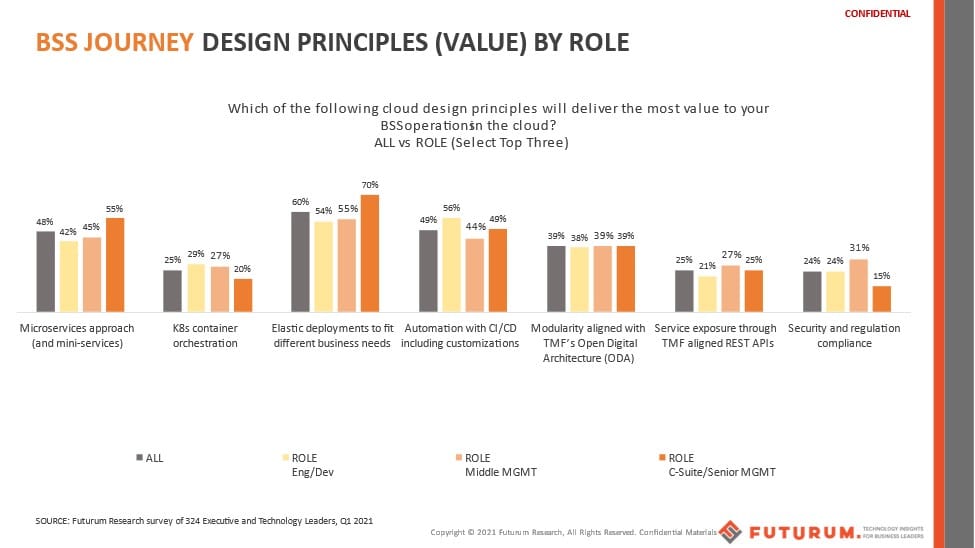The News: The Futurum Research report, “The BSS-to-cloud journey: Powering Innovation across the digital value chain”, done in partnership with Ericsson, is based on a survey of 324 communications service providers (CSPs). The report explores the BSS cloud journey, providing a status overview and detailing key patterns and different perspectives. The survey included vital insight on the value assigned to cloud design principles based on role within the CSP organization. What are the key takeaways in regard to the values CSP decision makers assign to cloud design principles? Download the report.
The Top Cloud Design Principles in BSS-to-Cloud Journeys Identified by CSP Decision Makers
Analyst Take: Our survey addressed the fundamental issue of cloud design principles in powering cloud BSS journeys and what are the top design principles selected by the participants based on their roles across the C-Suite/Senior Management, Middle Management, and Engineering/Developer categories. Among CSP decision makers, the top three design principles chosen out of seven options consisted of:
- Elastic deployments
- Microservices
- Automation

By moving towards cloud design principles, CSPs can lock-in key financial, operational, and technological benefits while getting ready to fulfill new 5G use cases as they become reality. Both private and public cloud adoption are enabling CSPs to reduce costs and improve agility within their technology and financial frameworks when used for BSS components while also meeting their regulatory and legal obligations. The key cloud design takeaways included:
- 70% of C-Suite/Senior Management rate Elastic Deployments as their top choice, compared to only 54% of Engineering & Development staff, 55% of which rate Automation with CI/CD and customizations as their top choice. This shows the divergence between the C-Suite and staff perceptions extends to prioritizing cloud design principles, suggesting that attaining organization-wide focus and commitment to unified cloud journey objectives is still a work in progress.
- Based on the aggregate “All” roles category, Elastic Deployments was selected as the top principle, indicating its importance in improving time-to-market, assuring rapid scaling of services and applications that meet specific customer demands, and “right sizing” service parameters according to on-demand and vertical use case requirements.
- Mircoservices followed Elastic Scaling as the cloud design principle that will deliver the most value showing that CSPs are committed to using networking slicing to meet customer requirements, especially in 5G environments. Through a microservices architecture, I see CSPs achieving the agility needed to compose applications from independent and loosely coupled services and deliver use case networking that deliver contextual experiences according to specific customer requirements.
- Automation rounds out the top three principles as it uses programmable logic to manage BSS processes and resources across all cloud environments, allowing CSPs to scale, protect, and integrate BSS applications more swiftly than using legacy manual approaches.
My colleague Shelly Kramer and I covered the top cloud design principles in BSS-to-cloud journey identified by CSP decision makers in our “Futurum Research BSS-to-Cloud Journey Survey: How Operators Can Advance Their Journey” episode of the Futurum Tech Webcast this last week. You’ll find our discussion on that topic here:
You can watch our brief discussion here:
Or listen here:
Disclaimer: The Futurum Tech Webcast is for information and entertainment purposes only. Over the course of this podcast, we may talk about companies that are publicly traded and we may even reference that fact and their equity share price, but please do not take anything that we say as a recommendation about what you should do with your investment dollars. We are not investment advisors and we do not ask that you treat us as such.
Other insights from Futurum Research:
Moving BSS Cloud Journeys Forward – Transforming the Monetization Engine of Investment
Transcript:
Ron Westfall: And I think it ties into another important takeaway from the survey, in what are the top cloud design principles that the operators are looking at? And there was naturally, a wide array of options, all of them compelling in their own way. However, the top three that came out of that was first of all, elastics deployments, being able to have that built-in ability to meet the needs of the customer, but also the context.
And you think, okay, well, it shouldn’t just be a matter of scaling. And actually, most of it will be like being able to scale more. By having elastic scalability, the operator can bring on more customers quickly, can bring on more applications rapidly, et cetera. But it’s also about, again, that context. For example, we talked about the stadium use case, where you have 50,000 or 80,000 people all gathered at once. And certainly, there’s going to be a surge in demand…
Shelly Kramer: Right.
Ron Westfall: … for bandwidth and other policy and intelligence capabilities to make that experience optimal for those who are subscribing to that. But as we know, that event ends. And then suddenly, the bandwidth requirements get throttled back.
And then, what you really don’t want is that legacy issue of what was called stranded bandwidth. You had to build out X amount of bandwidth to that stadium to enable those capabilities. And well, that’s where it stood, even when the stadium wasn’t being used for long stretches of time.
Shelly Kramer: Right.
Ron Westfall: And that certainly came out during the pandemic, where that would have been even more of a liability. And so it’s that elastic deployment capability. Most of it will be up scaling or being able to bring on more, but it’s also about right-sizing and being able to address the contextual experience. The other top three design principle is microservices.
Shelly Kramer: Right.
Ron Westfall: And so we need to address that. That’s also aligned with enabling network slicing. And what’s important here, it’s enabling the operator to use containers, to use Kubernetes’ orchestration capabilities to fundamentally create a service when the customer wants it.
Or to be able to serve a vertical more specifically, so you create from the existing network, a specific service that meets the needs of say, a manufacturing plant.
Shelly Kramer: Right.
Ron Westfall: That meets the needs of a mining operation, and so on and so forth. So I think this is going to be a big difference maker as to why this is going to be worthwhile, why the operators are going to be essential in the digital ecosystem within the 5G era.
And the third one is our friend, automation. I think we’ve seen how this can be better enabled. Part of it is just building into the applications and building into the processes, automation. Once tasks that were done manually, are now automated.
And again, this can help the entire workforce. But it also shows why there’s so much investment focus on AI and ML capabilities, because those are going to be the things that will enable this automation, certainly on a mass scale basis, on an Agile basis and so forth.
Shelly Kramer: Right.
Ron Westfall: There’s just no way around that. So it’s good to see that being tied in, in our viewpoint and in our perspective on the BSS to cloud journey.
Author Information
Ron is an experienced, customer-focused research expert and analyst, with over 20 years of experience in the digital and IT transformation markets, working with businesses to drive consistent revenue and sales growth.
He is a recognized authority at tracking the evolution of and identifying the key disruptive trends within the service enablement ecosystem, including a wide range of topics across software and services, infrastructure, 5G communications, Internet of Things (IoT), Artificial Intelligence (AI), analytics, security, cloud computing, revenue management, and regulatory issues.
Prior to his work with The Futurum Group, Ron worked with GlobalData Technology creating syndicated and custom research across a wide variety of technical fields. His work with Current Analysis focused on the broadband and service provider infrastructure markets.
Ron holds a Master of Arts in Public Policy from University of Nevada — Las Vegas and a Bachelor of Arts in political science/government from William and Mary.







